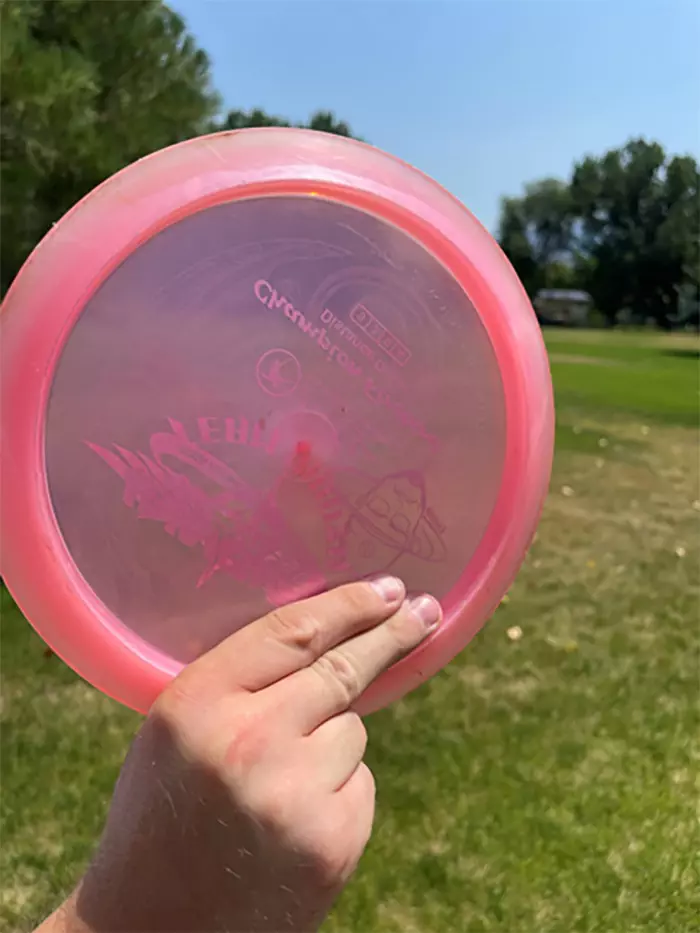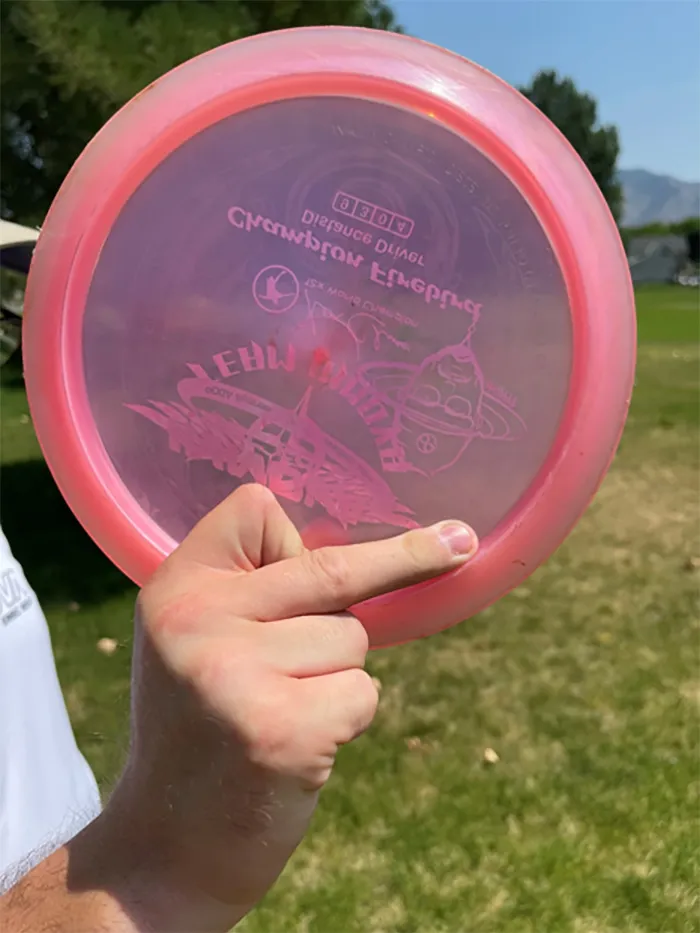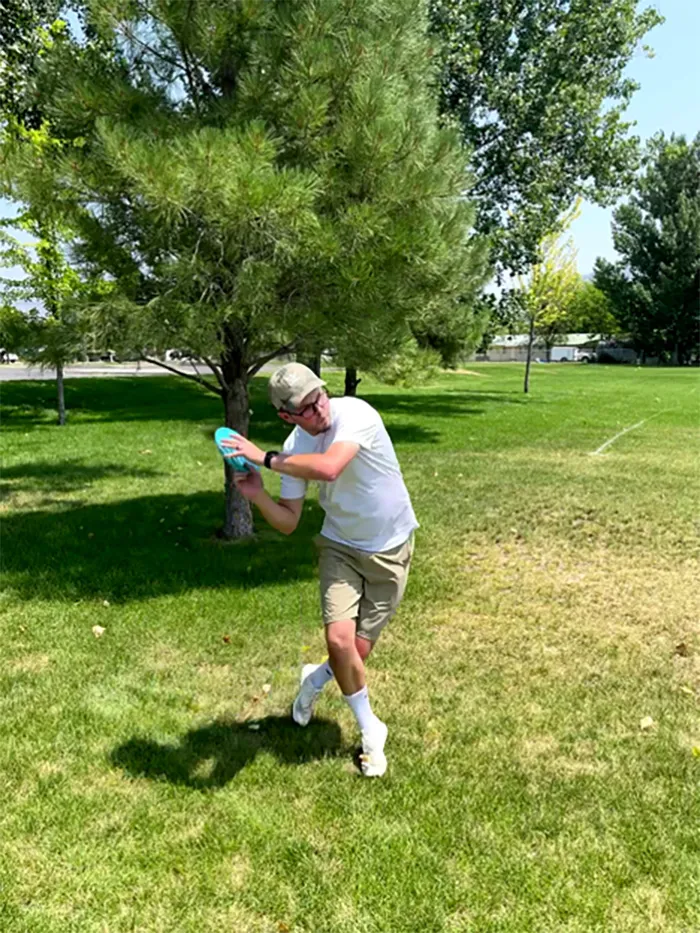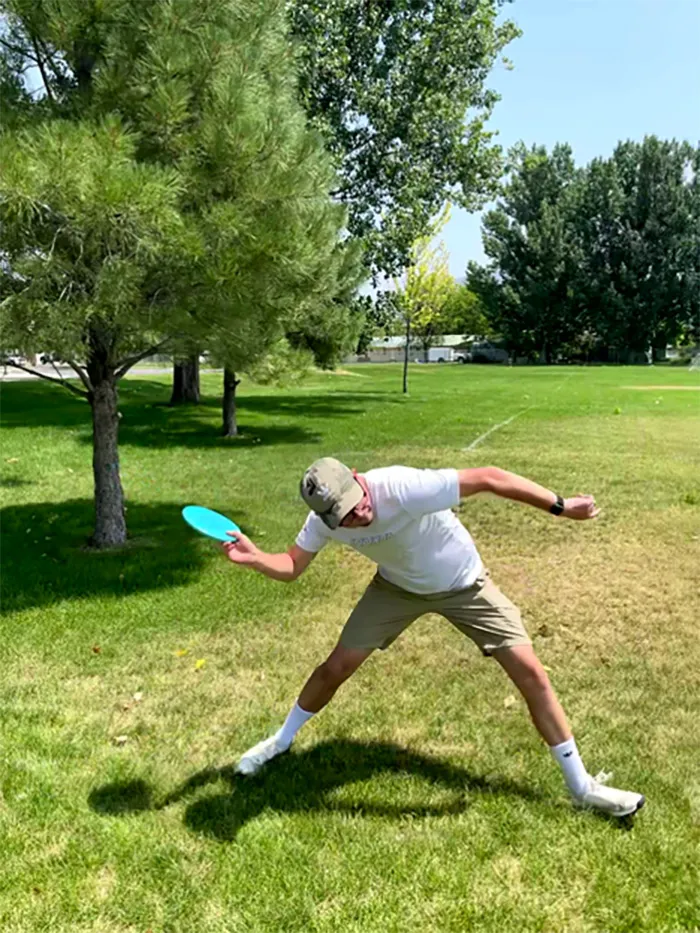Last updated on February 5th, 2024 at 05:27 pm
Last updated by Simon
One of the weak parts of my disc golf game has always been my forehand throw in disc golf. My buddies have been telling me for years to throw an occasional all-forehand round to improve that skill. However, my logic has always been not to detract from my bread-and-butter backhand practice time. Recently, I’ve started using forehand shots (also known as ‘flick’ shots or ‘sidearms’) for short approaches, and I appreciate their feel and accuracy. So, I decided to start regularly including throw a forehand in disc golf during my fieldwork. Here is what you need to know about the forehand.
Why a forehand?
One of the fundamental parts of a disc golf throw is how the disc finishes its flight. For a right-handed player, generally speaking, when a disc is thrown with a backhand throw, it will end its flight fading to the left. With most disc golf courses, designers include holes that require a variety of shots. If a hole is a dogleg to the right, for example, the backhand shot becomes very challenging. While backhand throws with understable discs are an option, mastering the forehand allows a player to release the disc as intended, finishing to the right. Additionally, throwing a forehand enables the player to maintain constant focus on the target throughout the throw—a valuable advantage. Many former baseball players favor the forehand because its motion resembles a sidearm throw.
Grip
The first thing to consider about the forehand is the grip. A proper grip helps control the angle of the disc. A good grip also optimizes spin on the disc by allowing the middle finger to push the disc and generate more rotation. There are several popular disc golf forehand grips, and they are all effective. Finding the one that works for you is the important part. Luckily, several of them feel fine and work for me. For practice and consistency, I settled on the stacked grip. Here are the most common choices.
Stacked

Achieving the stacked grip involves placing the middle finger on the index finger and positioning both of them on the inside of the rim of the disc, where the rim meets the flight plate. Position the thumb on top of the flight plate, while the remaining two fingers offer support outside the rim.
Power Grip

To create the forehand power grip, bend the index finger until it touches the inside of the rim, and position the extended middle finger where the rim and flight plate meet. Like the stacked grip, the thumb is on top and the remaining two fingers are outside the rim.
Forehand Fan Grip
In the fan grip, separate the index and middle fingers, with the middle finger touching the rim and flight plate, and extend the index finger to the middle of the disc. Use the other three digits in the same manner as previously mentioned. This grip prioritizes angle control over power, although it can still generate a significant amount of power.

The preceding three grips account for the most popular grips used. Nate Sexton has a rather unique grip, with the index and middle fingers bent slightly and contacting the inside of the rim. He does that because it fits his particular hand, and it works very well for him. He is one of the most proficient disc golfers in the world. His style just goes to show you that YOU need to find the style that works for you. Even if that means modifying an existing grip.
Forehand Form
Wrist
One of the unique aspects of the forehand shot is the method it employs to generate spin. Unlike the backhand shot, which generates spin as the disc is pulled in a straight line to the power pocket, the forehand shot relies on active wrist movement for spin. This wrist action is crucial, especially in obstructed shots, where a full throw may not be possible. Developing the skill to generate significant wrist-driven spin can help disc golfers successfully navigate challenging situations.
Footwork

While many players use the x-step as a common method to generate maximum power with a backhand shot, they still employ various styles to execute this technique. The same applies to the forehand shot, where some individuals utilize a mini x-step, while others employ a crow hop to prepare for the throw. Regardless of the chosen form, footwork is essential for setting up the reach-back and positioning the body for the throw.
Reach Back

Unlike the straight reach back and pull of the backhand throw, the forehand reach back is more back and up. This allows players to generate more speed on their throw as they bring the disc down into the straight part of the throw. It can also help with timing, since the forehand shot still uses hips, knees, and upper body.
The Throw

The typical form for a throw, and one that generates the most speed and spin, is one that involves many parts of the body and many joints. The upper body bends to the right, allowing the right forearm to be parallel to the ground. The right wrist is cocked back and prepared for the snap. As the player pushes off the back lag, he plants the lead foot, and then the magic happens. Leading with the elbow and keeping it level with the hip, the thrower drives it forward as far as possible, then whips the forearm, snapping the wrist and hips to transfer all the energy, power, and spin into the disc!
How Do You Throw a Disc Golf Forehand?
Honestly, there are several variations in this throwing technique, but many players have used the method we will show. Please check below on our breakdown on how to do a proper forehand throw.
The Proper Grip
There are a lot of several ways to grip a disc in disc golf. And this is the same with throwing forehand, where other players use a different type of grips. I know three popular grips used by professional players: the stacked grip, forehand power grip, and forehand fan grip. I will not discuss each of the grips in detail, but the point is, every player must have their preferred grip when throwing forehand.
Whatever your preferred grip is, you need to be comfortable with it when throwing the disc. You cannot just copy a type used by a famous pro disc golfer and expect the same result. Learn how to find the grip that suits your hand that offers a lot of comfort. From there, learn the correct way to do it and start practicing on the field.
The Proper Reach Back
If learning how to throw a disc golf backhand needs you to familiarize the proper reach back, you’ll need to do the same when throwing a forehand, albeit in a different technique. The backhand’s reach back is more of a straight line, while the forehand can be comparable to a baseball throw, golf swing, and other similar movements.
If you are a beginner, starting it low is good while adjusting the height once your skill progresses. Throwing it low enables quick disc flicking, engaging the wrist for a smooth, rapid release. Once your wrist is trained, extend your reach during forehand throws. To generate more power, bend over and align your elbow with your hips.
In the beginning, the hips should be facing the direction of where you are going to throw. The foot movement should start with taking a step forward with right foot, then step with the left foot forward at a 90-degree angle. Then use the right foot to push the other foot move forward initiating the throw. This is the footwork of the forehand throw.
As you start bringing the disc across your body, let the weight of your back leg transfer to your front leg. Then start to explode your hips, facing forward in the direction of your throw. After that, snap release the disc while taking a step forward and letting your arm come across your body.
Tips to Improve Your Forehand Throw
Having a good forehand throw will need you to have the following factors: balance, control, speed, power, and follow-through. All of these factors are required if you want a good forehand throw. But to be able to do that, please follow the tips below:
- The upside of using a forehand throw is you are generally facing the direction you are throwing the disc. You can use this advantage to aim for the basket and focused on your goal to achieve the distance you want.
- If you are still new, learn how to throw forehand with shorter shots using midrange or putters. This action is to familiarize yourself and your hand with the different movements that the forehand throw requires. But once your knowledge and skillset progresses, you can now increase the power and use the long-range disc in your throws.
- Select good forehand discs. The nature of a forehand shot makes it very difficult to consistently and accurately throw understable and domey discs consistently.
- When throwing a forehand, you want to make sure that the disc is positioned back in your hand while the wrist should be the full support extension. Doing this step gives you the entire motion while the wrist will drive the disc’s momentum moving forward.
- You need to find a way to push the disc using your middle finger during the release time. This action is to make more spin while also increasing the disc’s rotation, which is crucial when throwing forehand.
- You need to have a firm grip on the disc before you make the throw. This action can be done if the disc is completely tucked in your hand without any visible spaces in between. Having a firm grip on the disc will provide a lot of control and a clean release.
Many disc golfers see a lot of disc flutter or wobble when throwing forehand, but this can be easily corrected. By learning how to grip firmly and make sure that there is no loose or bad connection between the disc, it will have more spin and station to increase its stability during the flight.
Conclusion
The forehand shot is certainly an important tool in your arsenal that will help you save a few strokes and improve your scores. If you don’t throw forehand, it would be worth your time to learn the basics. Even if you only pull out the forehand when you are in trouble, it would be great to know you are comfortable with it and can execute your shot. Check out a few of these videos for more tips on throwing the
